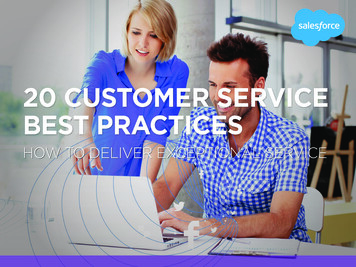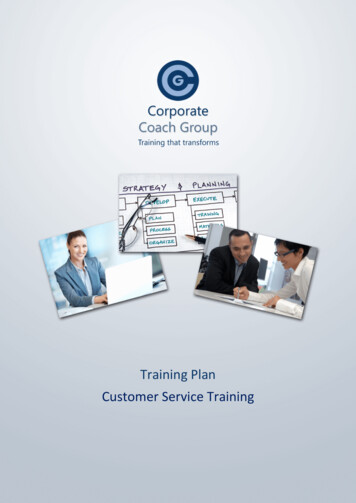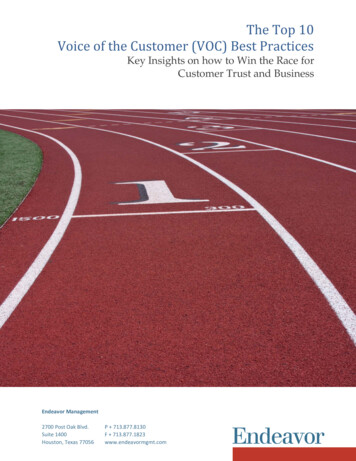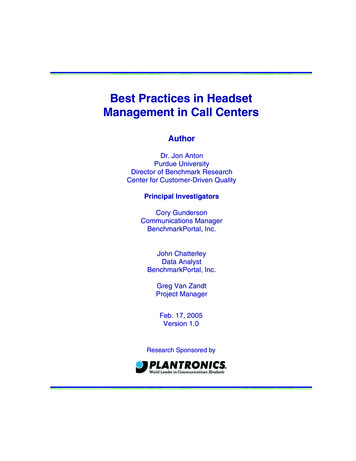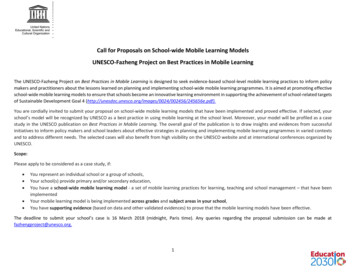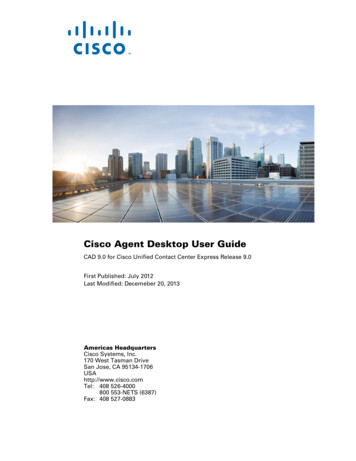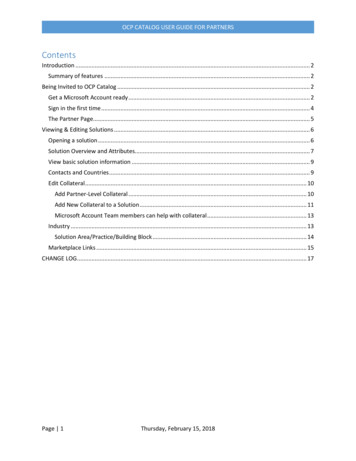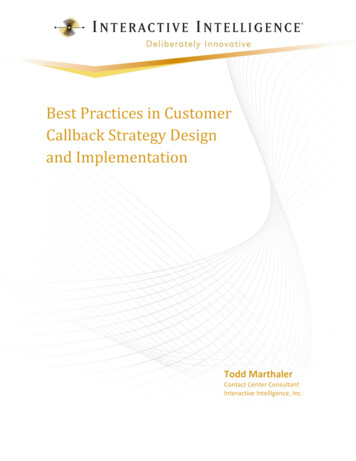
Transcription
Best Practices in CustomerCallback Strategy Designand ImplementationTodd MarthalerContact Center ConsultantInteractive Intelligence, Inc.
ContentsWhat is a callback?. 3How does the Interactive Intelligence solution handle callbacks? . 3Can contact centers offer both in queue and scheduled callback options to thecustomer? How would that be handled? . 4Can the contact center confirm the return call phone number or request alternatecallback numbers from customers for either in queue or scheduled callbacks? . 4Are callbacks a good thing? What is the impact on customer experience? . 5When should in queue callbacks be offered? . 5When should schedule callbacks be offered? How often should numberbe called back?. 6What options exist for dispositioning and re-queuing callbacks? . 6What are some practical applications for the use of callbacks? . 6Should we pilot the callback program before rolling it out? . 6How should the success of a callback program be measured? . 7How is service level tracked for callbacks? . 7Does Interactive Intelligence provide standard reporting for callbacks? . 7Examples of Current Reporting for Callbacks: . 8Report Descriptions and Metric Definitions: . 9What is the impact of a successful callback program on agent head count?. 10What do we recommend? . 10In summary . 10Are callbacks a good thing? . 10How are callbacks best applied? . 10What is the best use of callbacks? . 11What contact center challenges may callbacks address? . 11What are the staffing impacts?. 11The Author . 12Copyright 2014 Interactive Intelligence, Inc. All rights reserved.Brand, product, and service names referred to in this document are the trademarks or registeredtrademarks of their respective companies.Interactive Intelligence, Inc.7601 Interactive WayIndianapolis, Indiana 46278Telephone (800) 267-1364www.ININ.comPublish date 08/14 2014 Interactive Intelligence, Inc.2Best Practices in CustomerCallback Strategy Design and Implementation
The pursuit of customer loyalty is the central focus of most organizations. Yourcustomers are increasingly less tolerant of service that does not meet theirexpectations, more vocal in expressing dissatisfaction through social media, and morefickle in their relationships with your company. Earning customer loyalty today hasnever been more challenging, which means your organization can’t leave any aspect ofthe customer experience to chance. Implementing a customer callback strategy is onemore tool to consider adding to your customer service toolbox. Thinking aboutimplementing customer callbacks? We’ve put together this playbook to help you ensureyou’re in alignment with customer callback best practices.What is a callback?A callback is a feature that provides queued customers with the option to receivea callback as opposed to waiting in queue or opting to abandon their callbefore it’s answered.How does the Interactive Intelligence solution handle callbacks?Interactive provides two options for handling customer callbacks: Option 1: In queue callbacks allow the customer the option to register theirdesire to receive callback prior to disconnecting, maintain their place in queue,and receive a callback when an agent becomes available. This method simplyinitiates the callback to the number provided by the customer when an agentwith the required skills becomes available to handle the call. Callback requestsretain place in queue, priority and/or skill assignment associated with theoriginal interaction regardless if the caller selects the same number or to enter adifferent number for the callback.Option 2: Scheduled callbacks provide the customer with the option to select atimeframe in which they would prefer to receive a callback. Scheduled callbackscan be configured in the IVR or can utilize Interaction Dialer for more specificrequirements, including agent-owned callbacks. Once the scheduled callback isqueued, the system dials the call at the designated time. Scheduled callbacksrequire additional customizations and applications. The callback schedulercustom application is needed if a caller or a website user wants a callback at aspecific time. 2014 Interactive Intelligence, Inc.3Best Practices in CustomerCallback Strategy Design and Implementation
Can contact centers offer both in queue and scheduled callback options tothe customer? How would that be handled?A Customer may be offered both an in queue and a scheduled callback during the samequeued interaction. In queue callbacks would be offered first to the customers’ basedon the assumption that they called the contact center when it was most convenientfor them. Scheduled callbacks may be offered as a secondary option if the customerdoes not opt for the in queue callback, providing an additional option that may appealto the customer.Note: If a contact center uses Interaction Dialer, there is no Service Level reporting, onlyreporting on attempted outcomes for each call. Unless you are using Interaction Dialerfor other outbound dialing functions, leveraging customizations in the IVR and theCallback Scheduler application is all that is required. The contact center can opt to useDialer for scheduled callbacks if they are also using Dialer for other agent and agentlessoutbound campaign functionality.Can the contact center confirm the return call phone number or requestalternate callback numbers from customers for either in queue orscheduled callbacks?We recommend asking the customer to confirm the return call phone number forcallbacks. This increases the probability of a successful callback if the number fromwhich the customer is calling (ANI) is not a direct number. For example, if the customeris calling from their workplace, the ANI might be the number tied to the switchboardand not directly routed to the customer. If a customer can enter a direct number, thecallback will be made to the customer’s direct number. What are some potentialscripting options? For in queue callbacks, typical scripting is: “We apologize for your wait. Yourcurrent wait time is X. You may hold for the next available agent or we can callyou back. You won’t lose your place in line and will receive a callback at thenumber of your choosing. Would you us to call you back at (play current numberback to customer)? If yes, press 1. If you would like to enter another telephonenumber, press 2 and enter the phone number where it is best to reach you.”For scheduled callbacks, typical scripting is: “Thank you for calling. If you wouldlike us to call you back when it’s convenient for you, enter the telephonenumber you’d like us to use to contact you and select the time when you wouldlike to receive a call.”How would you approach combining in queue and scheduled callbacks? If you’d like tooffer both in queue and scheduled callbacks, the best approach is to offer the in queuecallback first. For example, “Thank you for calling. The current wait time is X. Please holdfor the next available agent, or you may choose to have an agent call you back withoutlosing your place in line. If you would like to receive a callback, press 1. You will beprompted to enter your callback number.” Should the customer choose to remain inqueue instead of selecting an in queue callback, the contact center may consider addingan option for a scheduled callback when the maximum average wait time for the queueis exceeded. 2014 Interactive Intelligence, Inc.4Best Practices in CustomerCallback Strategy Design and Implementation
Are callbacks a good thing? What is the impact on customer experience?A well-executed callback strategy can be an effective part of the overall customerexperience strategy. Callbacks provide a tactical situational value proposition toreduce abandons and manage peak volume times without sacrificing focus on thecustomer experience.Callbacks benefit the contact center by: Reducing customer abandon rates.Reducing agent idle time.Reducing handle time since the agent may be able to identify the caller’sinformation and reason for call prior to the callback.Saving telecommunication services costs.Callbacks are best used during peaks that the contact center can’t anticipate or stafffor, or short-lived situations. While every customer’s first preference is for their callto be answered quickly, customers are generally appreciative of the option to receivea callback under extenuating circumstances. From a customer experience perspective,continually being presented with a callback option every time the contact center iscontacted defeats the use of callbacks as a service-enhancing feature. The bestpractice is to plan and staff to answer customers’ calls by having the right number ofproperly trained and skilled people, in the right place, at the right time. Callbacks shouldnot be viewed as a substitute for effective workforce management. Long-termplanning, forecasting, scheduling and real time management are fundamental to a wellmanaged, highly functioning contact center and will be vital to supporting an effectivecallback strategy.A potential drawback in the use of callbacks can be the transaction handling efficiency.It’s a flawed assumption to view increasing the use of callbacks as a guaranteed path tohigher levels of efficiency. Because the callback is not occurring at the time thecustomer found it convenient to contact an organization, the callback attempt may onlybe that – a missed attempt at reaching the customer that may start an inefficient roundof return calls. Also, the inability to reach an agent by phone could result in thecustomer attempting to resolve their issue through multiple channels (e.g., first phone,then chat, then e-mail). Without the ability to identify that the same request wasreceived in multiple channels, the possibility exists for duplicate requests and rework tooccur (along with unnecessary agent expense). It is not unusual for 5 minute calls tomorph into 30 minutes or more of workload if the callback strategy is not well designedand executed.When should in queue callbacks be offered?In order to make your callback program most successful, you should first inform your customerof the longest average wait time. For example, if you know that your customers longest averagewait time is likely to abandon at 60 seconds, you may want to offer a callback within 30-40seconds, to coincide with their tolerance for waiting. This will improve the customer experienceand positively impact the center’s abandonment rate. It’s also important to note that callbacksshould be offered as an option. They should never be forced upon a customer. 2014 Interactive Intelligence, Inc.5Best Practices in CustomerCallback Strategy Design and Implementation
When should schedule callbacks be offered? How often should number becalled back?As a general rule, scheduled callbacks should be attempted three times with a 5 minutewindow between attempts. Scheduled callbacks are most successful and will supportservice level targets most effectively, when the callbacks are assigned to a workgroup,rather than to individual agents.What options exist for dispositioning and re-queuing callbacks?If a customer does not answer the callback on the first attempt, the agent may “snooze”the callback. This resets the callback for another attempt. If the subsequent callback isnot successful, the agent dispositions the call with a wrap code, or reason for call, and asecond disposition to mark the call failed if the customer is not reached or completed ifthe customer is reached. In both cases, this removes the call from the callback queue.What are some practical applications for the use of callbacks?These are examples of situations in which the use of the callback feature would beappropriate: Airline reservation centers when extreme weather disrupts passengertravel plans.Utilities during unanticipated widespread power outages.Small, specialized contact centers or business units that are less able to absorbvolume surges.Financial services when stock market prices make sudden and dramatic swings.Auto industry when major recall notices are publicly announced.Natural disasters affecting all business in the impacted region.New product release or marketing campaign that drives call volume beyondforecasted levels.Should we pilot the callback program before rolling it out?Yes. An initial pilot should be configured with the following parameters:1. Define a one-week test period for a single queue and workgroup leveragingin queue callback.2. Determine a short window of operational hours to offer pilot callbacks (e.g.,11am - 1pm).3. Promote the callback service to customers through email, web andIVR messaging.4. Configure the wait time in queue message based on less than the averageabandon time.5. Provide an option for play back of ANI and an option for the customer to enteran alternate callback number.6. Review calls offered, answered, abandon rate and customer feedback todetermine effectiveness. 2014 Interactive Intelligence, Inc.6Best Practices in CustomerCallback Strategy Design and Implementation
How should the success of a callback program be measured?Callbacks offered, answered, abandons and flow outs are all valid metrics fordetermining whether callbacks are successful. Other potential metrics include contactrate, cost per contact, and customer satisfaction. Contact rate reporting is a customreport and is not part of the Interactive Intelligence’s standard reports. Callback contactrates should correlate to customer retention rates, sales and revenue targets todetermine the long-term value of the program to the contact center and the enterprise.Callbacks may lessen the impact of high call volume periods on daily service level. Theoverall impact depends on how customers respond to callback offers and how manydecide to opt in rather than remain in queue. From a customer experience standpoint,customer satisfaction surveys should be used to gauge customers’ interest in andsatisfaction with the callback feature.How is service level tracked for callbacks?Service level is affected when a call or a callback is waiting in queue. If a caller waits inqueue and then selects to leave a callback, the call flows out (overflows) of the queueand an associated callback enters the queue. The initial Inbound Call Wait time does notimpact ASA or service level because the initial call was never answered. The inbound callcounts towards the number of flowouts logged in the system. Service level is impactedby the number of callback retries of a callback, and the agent’s indication of the callbackbeing a success or failure.Scenario 1: If the caller is offered a callback in the IVR, then the system wouldn’ttrack the service level of the inbound call as it not presented to the queue.Scenario 2: If the caller is offered a callback while waiting in queue, the call issent back to the IVR, disconnected, and a callback is then generated. Theinbound call is tabulated as a call offered and flowout, with the inbound callbacktabulated as both offered and answered. Each inbound call would be countedtwice: once for the inbound call and once for the callback. The inbound call would count as offered to queue and then overflow(flow out). The service level would not be affected by this inbound callbecause it was never answered. When the callback enters the queue, it would be counted as an offeredand eventually answered. Time to answer for the callback would startonce it enters the queue.Does Interactive Intelligence provide standard reporting for callbacks?Most of Interactive’s standard, out-of-the-box reports have the option use media typeas a report parameter. Callbacks are considered a media type like inbound calls, emailsor chats. Reports like the User Availability Reports, which do not display call data, do nothave media types. 2014 Interactive Intelligence, Inc.7Best Practices in CustomerCallback Strategy Design and Implementation
We recommend establishing separate workgroups for callbacks to allow for cleaner realtime statistics and queue management. Reporting is different between a call and acallback. Real-time statistics such as, “Interactions Waiting”, “Longest InteractionWaiting”, “Service Level”, “Wait Time”, are combined if both calls and callbacks occurwithin the same workgroup queue. If the contact center agent is constantly re-trying thecall, then handle time will be different than a live call.Currently there isn’t a standard report to indicate success rates for callback attempts.Agents may indicate whether the callback was a success, failure, or retry the call, whichmay be reported on in a custom report.Examples of Current Reporting for Callbacks: 2014 Interactive Intelligence, Inc.8Best Practices in CustomerCallback Strategy Design and Implementation
Report Descriptions and Metric Definitions:Queue Detail Report: The Queue Detail report shows the number of callers that optedfor a callback including workgroup queue statistics such as: Offered – Defined as the number of callers who opted for a callback.Answered – The number of callbacks that were answered by an agent.Abandon – Callbacks will never abandon.Flowout – The number of callbacks that waiting in the workgroup queue butwere somehow routed out of that workgroup queue before being answered.This would include “Grabbed Callbacks” and as well as callbacks that overflowdue to a preset timeout.ASA – The average speed of answer from the time the caller opted for a callbackto the time the callback was answered by an agent. By default this does notinclude time it takes the agent to actually place the outbound call. Note: RetriedCallbacks or “Snoozed Callbacks” do not effect time in queue.Average Talk – The average connected time to a callback (Including but notlimited to the time on Outbound calls).Average Hold – Time average hold time on a callback.Average ACW – The average time an agent was in follow up after a callbackwas disconnected.Average Handle Time – The complete handle time on a callback, including talk,hold, and after call work.Service Levels – The number of callbacks that were answered in your specifiedService Levels. Time to answer is defined as: “the time the caller opted for acallback to the time the callback was answered by the agent.” By default thisdoes not include the time it takes the agent to actually place the outbound call.Note: Retried Callbacks or “Snoozed Callbacks” do not effect time in queue.User Productivity Summary Report: The User Productivity Summary Report shows thenumber of callbacks that were offered to an agent including statistics such as: Offered – Defined as the number of callbacks that were offered to anagents’ station.Answered – The number of callbacks that were answered by an agent.Abandon – Callbacks will never abandon.Flowout – The number of callbacks that alerted an agents’ station but were notpicked up in that time. Otherwise known as Agent Not Answering (ANA).Average Talk Time – The average connected time to a callback (Including but notlimited to the time on Outbound calls).Average Hold Time – Time average hold time on a callback.Average After Call Work – The average time an agent was in follow up after acallback was disconnected.Average Handle – The complete handle time on a callback, including talk, hold,and after call work. 2014 Interactive Intelligence, Inc.9Best Practices in CustomerCallback Strategy Design and Implementation
What is the impact of a successful callback program on agenthead count?The impact of your callback program on agent head count is dependent on the businessand customer behavior, and will vary based on: When the callback feature is offered.Staffing levels to forecast.Acceptance of the feature by customers.It is conceivable that staffing levels could increase, decrease, or stay the same afterimplementing a callback program. The result depends on the strategy of your centerwhen deploying the callback feature.What do we recommend?The Interactive Intelligence Contact Center Consulting team recommends cautious andprudent use of the callback feature and proactively offering customers estimated waittimes while they wait in queue. Keep in mind that the use of in-queue callbacks willreduce the number of callers who abandon, since we can assume a percentage willchoose a callback rather than disconnecting. At first glance, this would seem to be abenefit; however, the result of keeping more callers in queue (both waiting callers andcallback callers) is that all callers will experience a longer delay than if the callbackcallers had abandoned the queue. A consideration with estimated wait times is to useranges for the expected wait announcements, as the expected delay can go down (orup) based on workgroup size, average handle time, long calls, customers who opt forscheduled callbacks at a later time, and other factors.In summaryAre callbacks a good thing?Callbacks are a valid, tactical, short-term solution to reduce the abandon rates andprovide another service option to customers. Callbacks should be leveraged only duringchallenging service level time periods that typically coincide with the need to deployadditional queue management strategies to maintain an acceptable customerexperience delivery. Never forget that customers’ first preference is for their call isanswered quickly when they choose to make that call. When used as a routine contactcenter tactic, callbacks can mask a bigger and more serious staffing problem.How are callbacks best applied?Callbacks should be offered at an interval that is less than your average abandon time sothe contact center can improve abandon rates and enhance the customer experience atthe same time. 2014 Interactive Intelligence, Inc.10Best Practices in CustomerCallback Strategy Design and Implementation
What is the best use of callbacks?Callbacks are best used as an option for customers during unanticipated, unplannedsituations where there is insufficient staff to handle the workload. Customer InteractionCenter looks at the queue before offering callback. If there are already greater than Xnumber of calls in queue or the average wait time is greater than X seconds, present thecaller with the option to leave a callback number. In this scenario, the system wasdesigned to offer the caller a second menu in queue after holding X seconds to stay inqueue or request a callback.What contact center challenges may callbacks address?Callbacks may lessen the impact of high call volume periods to daily service level andcustomer accessibility. The overall impact depends on how customers respond tocallback offers and the number that decide to opt in to the feature rather than waitin queue.What are the staffing impacts?The impact of callbacks on staffing are dependent on the business and customer andmay vary based on when the callback feature is offered, staffing levels to forecast, andacceptance of the callback feature by the customer. 2014 Interactive Intelligence, Inc.11Best Practices in CustomerCallback Strategy Design and Implementation
The AuthorTodd Marthaler is a 20 year veteran of the contact center field and aContact Center Consultant with Interactive Intelligence. Before joiningInteractive, Todd was a Business Analyst and Client Services Managerfor a top Interactive Intelligence Partner. Todd has managed severalmulti-channel and multi-site contact center operations with Fortune500 Companies in the retail, hospitality, utility, and service verticals. Todd has a passionand focus to positioning the companies he services to deliver the ultimate customerexperience. He has expertise in IVR and Call Flow Design, Workforce ManagementImplementation, Workflow Optimization, Operations Management, Quality Assuranceand Voice of the Customer programs. 2014 Interactive Intelligence, Inc.12Best Practices in CustomerCallback Strategy Design and Implementation
information and reason for call prior to the callback. Saving telecommunication services costs. Callbacks are best used during peaks that the contact center can’t anticipate or staff for, or short-lived situations. While every custo
